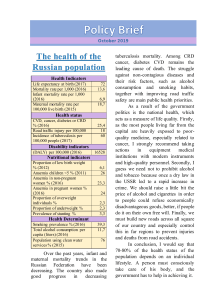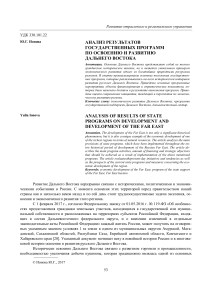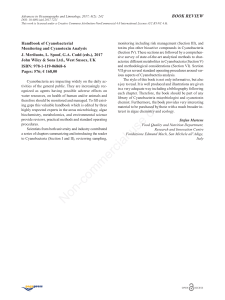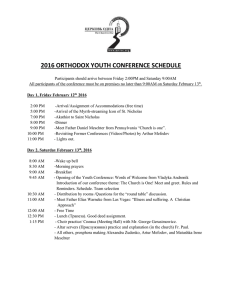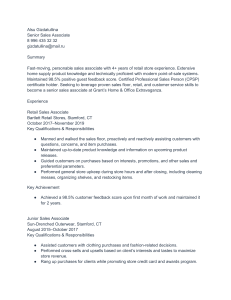Financial Statements of a Company as an Information Base for Decision-Making in a Transforming Economy
реклама
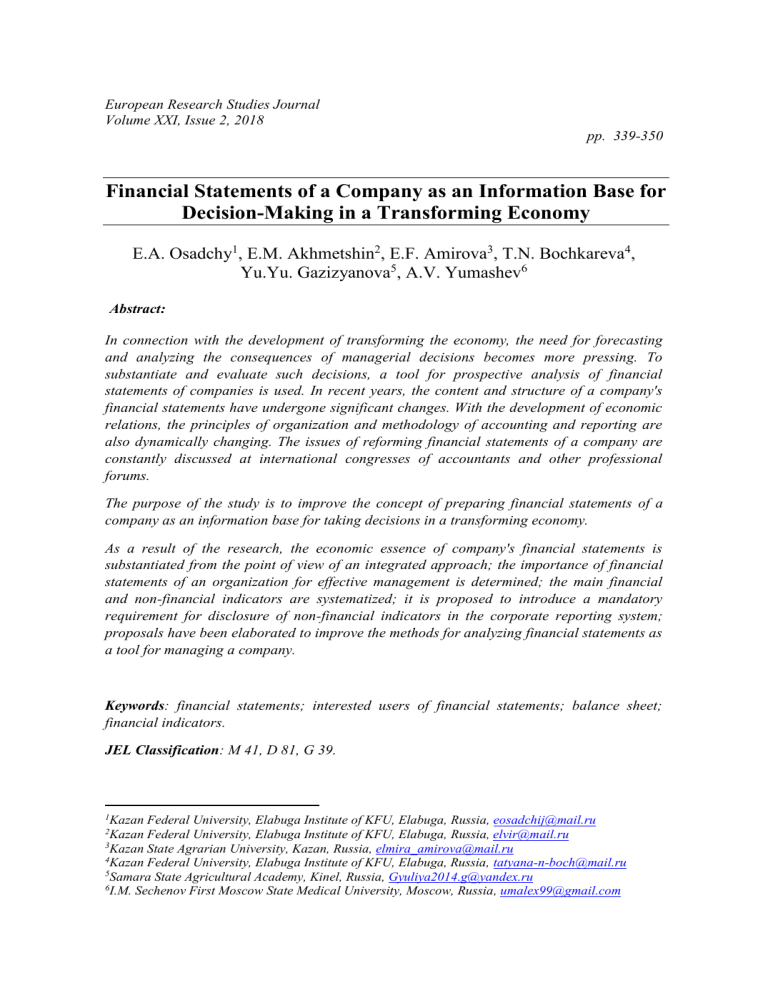
European Research Studies Journal Volume XXI, Issue 2, 2018 pp. 339-350 Financial Statements of a Company as an Information Base for Decision-Making in a Transforming Economy E.A. Osadchy1, E.M. Akhmetshin2, E.F. Amirova3, T.N. Bochkareva4, Yu.Yu. Gazizyanova5, A.V. Yumashev6 Abstract: In connection with the development of transforming the economy, the need for forecasting and analyzing the consequences of managerial decisions becomes more pressing. To substantiate and evaluate such decisions, a tool for prospective analysis of financial statements of companies is used. In recent years, the content and structure of a company's financial statements have undergone significant changes. With the development of economic relations, the principles of organization and methodology of accounting and reporting are also dynamically changing. The issues of reforming financial statements of a company are constantly discussed at international congresses of accountants and other professional forums. The purpose of the study is to improve the concept of preparing financial statements of a company as an information base for taking decisions in a transforming economy. As a result of the research, the economic essence of company's financial statements is substantiated from the point of view of an integrated approach; the importance of financial statements of an organization for effective management is determined; the main financial and non-financial indicators are systematized; it is proposed to introduce a mandatory requirement for disclosure of non-financial indicators in the corporate reporting system; proposals have been elaborated to improve the methods for analyzing financial statements as a tool for managing a company. Keywords: financial statements; interested users of financial statements; balance sheet; financial indicators. JEL Classification: M 41, D 81, G 39. 1Kazan Federal University, Elabuga Institute of KFU, Elabuga, Russia, eosadchij@mail.ru Federal University, Elabuga Institute of KFU, Elabuga, Russia, elvir@mail.ru 3Kazan State Agrarian University, Kazan, Russia, elmira_amirova@mail.ru 4Kazan Federal University, Elabuga Institute of KFU, Elabuga, Russia, tatyana-n-boch@mail.ru 5Samara State Agricultural Academy, Kinel, Russia, Gyuliya2014.g@yandex.ru 6I.M. Sechenov First Moscow State Medical University, Moscow, Russia, umalex99@gmail.com 2Kazan Financial Statements of a Company as an Information Base for Decision-Making in a Transforming Economy 340 1. Introduction In modern conditions, financial statements are the most complete, objective and reliable information base, based on which one can form an opinion on the property and financial position of a company (Thalassinos and Liapis, 2014). In accordance with the legislation, the accounting financial statements are an open source of information, and its composition, content and presentation forms are unified by basic parameters, it becomes possible to develop standard methods to read and analyze it (Suryanto and Thalassinos, 2017). Reporting is used by a company's management as the basis for making managerial decisions. Its data are necessary for the analysis of organization's activities. Thanks to it, it is possible to identify the causes of deviations from the previously established parameters and uncover unused reserves of production. Statistical bodies widely use the annual reports of many companies for various developments that allow determining the direction and level of production's development. The financial accounting data, obtained in the annual report, provide information which is necessary for top managers to finance investment projects. The essence of financial statements' analysis from the position of a user is to review and evaluate the information in the reporting to obtain reliable conclusions about the past state of an organization aiming at foreseeing its functioning in the future. Evaluation of financial statements is a process by which the past and current financial position and performance of the company are assessed. Because of financial statements' analysis, the company's most important characteristics are also determined, which testify, in particular, about its success or the risk of bankruptcy (Izuymov et al. 2017). For different users, in terms of the scale of its implementation, the analysis of financial statements depends on a specific goal. At the same time, the analysis and direction of work while analyzing financial statements can be different. Therefore, company's financial statements can be useful for different interested parties (Bondarenko, 2010). Preparation of financial statements is important for the successful conduct of the activities of any enterprise. It is connected not only with summarizing the results of its financial and economic activities for a certain period, but also with determining the quality of company's relations with public authorities that control the conduct of any economic activity in the state, including the activities connected with the receipt of profit (Gapsalamov et al., 2017; Bittman et al., 2017). Thus, depending on how timely the financial statements are presented by the company, there are penalties imposed on it, the frequency and severity of conducted tax audits. It is also an important fact that timely and high-quality financial statements are required to obtain a general picture of a legal entity's performance, its effectiveness, financial stability and other indicators (Korableva and Kalimullina, 2014). That is why the company's financial statements are important for its management and for external bodies. E.A. Osadchy, E.M. Akhmetshin, E.F. Amirova, T.N. Bochkareva, Y.Y. Gazizyanova, A.V. Yumashev 341 This topic should also be considered due to the fact that a careful study of balance sheets allows us to disclose both the secrets of successful and effective company performance, the reasons for failures and insolvency and identify factors that negatively affect the company's performance. Based on this information, plans can be adjusted and ways to improve the company's activities can be outlined. 2. Literature review Financial reporting is a unified system of data on the property and financial position of the company and the results of its activities. Financial statements are prepared based on financial accounting data in accordance with established forms for a certain reporting date. It follows from this definition that the data reflected in the financial statements essentially represent a special type of accounts that are extracted from the current accounting of the summary data on the status and performance of a company for a certain period (Korableva et al., 2017b). The system of accounting data (indicators) that make up the financial statements should be output directly from the ledger accounts – the most important register of the accounting system. The total of accounting indicators, which the financial accounting consists of, is formed directly or indirectly from the ledger accounts. Therefore, the reporting data grouped in the accounting registers cannot reflect such economic turnover, which were not presented in the current accounts. Hence there is the relationship between financial accounting and financial statements, which means that the resulting totals are transferred to the appropriate reporting forms in the form of synthesized, final indicators of the balance sheet and reflect the value of organization's assets by its composition and placement directions. The approaches of different researchers to the definition and interpretation of the concept of financial statements are considered in the Table 1. Table 1. The concept of financial reporting Source Anthony R. and Rees J. Definition Financial reporting provides information about the past to assist users in forecasting and deciding on the future financial condition and movement of assets of a business entity (Anthony and Rees, 2001). Holt, R.N. Financial reporting should contain information that is necessary for present and future investors, creditors and other users for making decisions on investing, issuing loans and borrowing, as well as implementing other similar solutions (Holt, 1993). Abib M., Catapan Analysis of financial statements is a preliminary step towards short-, E.A., Catapan A., medium- and long-term planning of the company's activities. The Catapan D.C., and system of financial reporting indicators contains four criteria: da Veiga C.P. relevance, reliability, comparability and clarity (Abib et al., 2015). Casta J., & The purpose of financial statements, its significance and value is to Ramond O. facilitate the possibility of multicriteria evaluation of the effectiveness of the performance of companies (Casta and Ramond, 2016). Financial Statements of a Company as an Information Base for Decision-Making in a Transforming Economy 342 Through financial reporting, the main objective of financial accounting is fulfilled, that is to generate complete and reliable information about company's property status and to provide this information to internal and external users (Bondarenko, 2009a). Astrakhantseva et al. (2016), consider cash flow statements as the information affecting the analysis of the company's economic security. This allows users to quickly assess changes in the company's net assets and its financial structure including liquidity and solvency (Vasilyev, 2015; Kurbanova et al., 2018). At the same time, Dlasková and Havlícek (2013) investigate the financing of managerial decisions, which becomes one of the fundamental parts of cash management process. Financing solutions in a firm are divided into two categories based on the source of finance (external and internal). The funds provided by external sources are collected by the company through the management of the capital structure, as well as the management of loans and borrowed capital. Internal sources are the company's profits. Therefore, based on sources of funding, the objectives of information users may be different. Thus, a review of modern literature allows us to conclude that research on the effective use of information management system of the company is widely discussed in online sources and various scientific journals. 3. Information users of company's financial statements By classifying users of financial statements' information on the economic basis, it is possible to identify external and internal users of information. The number of users of reporting is constantly changing and varies depending on specific economic conditions, while the interests of users in relation to its information content are quite constant. Users of financial statements are legal entities and individuals that are conditionally divided into two main groups: internal and external users (Figure 1). The first group includes the following external users: – shareholders of the company, founders, investors, existing and potential owners of the organization's funds, who need to establish an increase or decrease in the share of own funds and assess the efficiency of the resources' use by the company's management; – existing and potential lenders using statements to assess the appropriateness of granting or extending a loan, determining the loan condition, strengthening loan repayment guarantees and assessing the credibility of an enterprise as a client; – legislative bodies; – suppliers and customers, establishing business relationships with the client; – securities exchanges that evaluate the information provided in the reporting when registering the relevant firms, making decisions on the need to change accounting and reporting; E.A. Osadchy, E.M. Akhmetshin, E.F. Amirova, T.N. Bochkareva, Y.Y. Gazizyanova, A.V. Yumashev 343 – lawyers who need reporting information to assess compliance with contractual terms, compliance with the law in calculating profits and paying dividends, as well as determining the terms of pension provision; – press and information agencies, which require statements to prepare reviews, evaluate development trend and analyze activities of individual companies and industries, calculate generalized indicators of financial activity; – trade and production associations that use reporting for making statistical generalizations across sectors and conducting comparative analysis and performance evaluation at the sectoral level (Grahova and Gapsalamov, 2014); – trade unions, interested in reporting information to determine their salary requirements and terms of employment agreements, as well as to assess the development trends of the industry to which an enterprise belongs; – the state, first, acting by the bodies that check the correctness of drafting documents, calculating taxes and form a tax policy (Puchkova, 2015). Figure 1. Internal and external users of the company's financial statements Internal Users Board of Directors Managers Governing body Employees Heads of divisions External Users With direct financial interest With indirect financial interest Participants (owners) of the organization Tax and financial authorities Real and potential investors Servicing banks Government authorities Loan banks Insurance organizations Suppliers Buyers Without financial interest Statistical authorities Arbitration Exchanges Audit organizations The second group is represented by internal users: – company's management (who take managerial decisions); – managers of relevant levels who, according to the financial statements, assess the need for financial resources, the correctness of investment decisions and the effectiveness of the capital structure, determine the main areas of the dividend policy, prepare forecast reporting forms and perform preliminary calculations of the financial performance of the forthcoming reporting periods, assess the possibility of merging with another firm or its acquisition, as well as structural reorganization of the company; Financial Statements of a Company as an Information Base for Decision-Making in a Transforming Economy 344 – all structural units (branches, representative offices etc.). The study conducted by Ponce et al. (2015) is considered quite interesting. It is based on the survey and analysis of the questionnaire of 849 information users. The researchers concluded that users of companies' financial statements differ for their reasons for using financial statements (professional or private), in their profession, in their experience and in their point of view (for example, suppliers are interested in the information about the solvency of the analyzed company, investors are interested in the profitability of the company). Therefore, it can be concluded that each user has a certain interest. 4. Methodplogy The theoretical basis of this research is represented by the scientific provisions contained in the works of foreign and Russian scientists, experts in accounting, audit, financial analysis and decision theory (Fedotova et al., 2017). The regulatory legal acts of the Russian Federation, the provisions of IFRS and GAAP, publications in the periodical press, databases of the Federal State Statistics Service and its territorial body for the Republic of Tatarstan, the results of statistical and sociological research in Russia and abroad, information materials analytical agencies, as well as information resources of the Internet (Kosintseva et. al., 2017). The methodological basis of the research consisted of general scientific methods (dialectical method, methods of system and structural and functional analysis, historical and comparative methods). These methods were used in a different combination and at different stages of the study, depending on the goals and objectives. Surely, it has contributed to ensuring the reliability of the analysis and the validity of the conclusions reached by the authors. 5. Results To improve the information content of company's financial statements and systematize the identified indicators, the authors propose the following: – to add to the profit and loss statement additional indicators that reflect income and expenditure indicators, i.e. indicate revenues in the indicator "Proceeds from the sale of products", and in the indicator "Revenue from work and services", respectively, to distribute the cost of goods and services sold in the following indicators: "Cost of sales", "Cost of work performed"; "Cost of services rendered". – in addition to the explanatory notes to the balance sheet and the financial results report, it is recommended to compile the balance sheet and the financial results report in the form of separate subdivisions. The detailed form of the financial results report is a standard financial results report, supplemented with additional lines that classify each indicator for each separate subdivision. – transformation of the balance sheet of Russian companies in accordance with international financial reporting standards. Transformation does not require the E.A. Osadchy, E.M. Akhmetshin, E.F. Amirova, T.N. Bochkareva, Y.Y. Gazizyanova, A.V. Yumashev 345 mandatory availability of specialized programs and can be performed using spreadsheets, for example, MS Excel. To transform the company's reporting, it is necessary to develop a common strategy, which can be presented in the following way (Korableva and Kalimullina, 2016). First, there are discrepancies in financial indicators. For this the following is performed: – inventory of stocks at the reporting date, during which their market value is determined; – inventory of accounts receivable to accrue a reserve of doubtful and bad debts; – inventory of capital stock for establishing their net market value and impairment caused by the moral and physical deterioration of current operating assets. Second, three groups of reporting indicators (production, innovative and financial) are identified and systematized. The systematic approach calls for the need to consistently identify and evaluate the main activities of the enterprise. Based on the financial statements, the following activities, performed by the company are distinguished: production; innovative; financial. Third, a transformation model is being developed – a set of spreadsheets into which the financial reporting data is entered, including adjustments. A condition for the stable development of a company in performing each type of activity is the choice of estimated indicators. They should meet the requirements of rationality and sufficiency, since with its help one can characterize the results of one or another sphere of company's functioning. The proposed systematic method makes it possible to evaluate not the established results, but the trends of their appearance, the process itself and the driving forces of its functioning (Figure 2). Only in such a set of indicators is determined the actual development of the company, its true potential in business cooperation and is revealed the full realization of all its interests and its counterparties purposes. Transformation of the reporting enables to achieve the following results: – the ability to automate the accounting process through the introduction of a CRMsystem. This will automate the strategy of interaction with customers (clients) to increase sales, optimize marketing and improve customer service by storing customer information and the history of relationships with them, establishing and improving business procedures and subsequent analysis of results; – saving time and effort (Vasilev and Tuktarova, 2014; Bondarenko, 2009a; Kilinc et al., 2018; Sadykova et al., 2017; Tabachuk et al., 2018); – transparent adjustment system – adjustment postings are immediately reflected in the reporting. The implementation of the proposed activities will maximize the profit and profitability of the company by improving the quality of accounting information. Financial Statements of a Company as an Information Base for Decision-Making in a Transforming Economy 346 Figure 2. Key indicators characterizing the company's development Development of the company Production activity Innovative activity Financial activities Indicators characterizing the production activity Indicators characterizing innovation activity Indicators characterizing financial activities The level of physical deterioration Share of innovative products in total output Profit of the organization Coefficient of receipt (input) of fixed capital Share of expenses for carrying out innovative measures in the total costs of the enterprise General degree of solvency Coefficient of renewal of fixed capital Coefficient of disposal of fixed capital Coefficient of current debt coverage Effectiveness of innovation Absolute liquidity ratio The coefficient of innovative activity of employees The coefficient of autonomy (financial independence) 6. Discussion The research by Sakai et al. (2015) considers one of the main determinants of creating information for external recipients (such as investors, banks, insurance companies, treasury administration bodies etc.). The source of such information is the accounting system, consisting of two subsystems: financial accounting (focused on the external recipient of information) and management accounting (providing information to internal recipients). The comparative analysis of Fraser’s et al. (2009) research with the Sakai et al. (2015) method is of interest. The Sakai et al. method was originally proposed to extract causal information on financial indicators that characterize the performance of companies. The results of the comparison showed that the method proposed by Fraser et al. wins the Sakai et al. method and indicates a problem of inaccuracy of the information received by the analyzed companies. The research of Dwi Karya Susilawati (2015) reflects the impact of business ethics, corporate governance, the views of an auditor and owners on the quality of financial statements after they have taken their decisions. This study examines the various ways that lead to the growth of the company. The growth of the company partly depends on the creativity of the employees working in it. It was noted that it is easier to fix the problem of completeness and transparency of information at the very beginning of preparing the statements. E.A. Osadchy, E.M. Akhmetshin, E.F. Amirova, T.N. Bochkareva, Y.Y. Gazizyanova, A.V. Yumashev 347 7. Implementations Summarizing the above-said information, it can be stated that the essence of the company's financial statements is to achieve a balanced state that allows it to carry out expanded reproduction and provide economic relations with other economic entities regarding the formation, distribution and use of resources. The performance of the company should be evaluated in such a way that all those who are connected with it by economic relations should be able to get an answer to the question: how reliable the company as an economic and strategic partner in these relations is, and, consequently, make a management decision on the economic profitability of the continuation or starting joint activities with it. Evaluation of the company's development should be carried out from the position of the system approach. It can be implemented by identifying key indicators that directly or indirectly reflect the perspectives of all stakeholders in the effective operation of the company: owners, management personnel, employees, investors, creditors, society, etc. (Hanias et al., 2012). When evaluating the company's activities, it is more expedient to be guided more by production, innovation and financial indicators. It is they who characterize the company's real ability to constantly develop (Korableva et al., 2017a; Tarman, 2016). It should not be forgotten that in the company's scorecard, not only the calculation of indicators is important, but also the identification of the interest of users of analytical information. The author's vision of the application of the system approach is as follows. Financial reporting is the information base of financial analysis, the results of which can be used to manage the financial and economic activities of the company, to assess the effectiveness of its management, to choose the directions for investing capital. Based on the system indicators of financial reporting (financial, investment, innovative), interested users analyze the property and financial position of the organization, its solvency and financial results. Thus, financial reporting allows us to satisfy information requests of all groups of users, which make special demands on its content and order of formation. 8. Conclusions The increased requirements for the reliability of financial statements have changed the approach to assessing the company's performance as one of the ways to identify and prevent material misstatements in the reporting. The study showed that to ensure the reliability of financial reporting, it is required to use a variety of means, among which a special place is taken by a systematic approach to analytical procedures. The authors believe that analytical work, which plays an important role in identifying and preventing misstatements in the reporting, should take a leading place not only in the accounting work of the company, but also in the work of Financial Statements of a Company as an Information Base for Decision-Making in a Transforming Economy 348 information users. Therefore, the financial statements of the company can basically satisfy the information requests of all groups of users who raise special demands on its content and the order of its formation. Financial reporting and its analysis serve as a tool for identifying problems of managing the financial and economic activities of the company, to choose the directions for investing in capital and forecasting certain indicators and financial performance in general. Careful study of financial statements permits to disclose both the secrets of successful and effective company's performance, and the reasons for failures and insolvency. Moreover, it helps to identify factors that adversely affect the company's performance. Based on this information, plans can be adjusted and ways to improve its operations can be outlined. For internal users, the financial statements of the company, as well as the accounting data that formed the basis for its formation, are important indicators both for operational management and for monitoring the safety of their property. The financial statements act as a means for users of reporting information to monitor the company's operations, promptly warn and identify signs of the bankruptcy of the company, form a unified state statistical survey base and macroeconomic indicators that can be used for tax purposes and for other purposes. In conclusion, it should be emphasized that in the context of economic transformation, the expediency of an integrated and systematic approach to the study of the company's financial statements is possible only based on international experience. Acknowledgements: The work is performed according to the Russian Government Program of Competitive Growth of Kazan Federal University. References: Abib, M., Catapan, E.A., Catapan, A., Catapan, D.C., Da Veiga, C.P. 2015. Financial statement analysis as a preliminary step to short, medium and long-term planning in Brazil: A case study in votorantim cimentos. Espacios, 36(8), 4-4. Anthony, R., Rees, J. 2001. Accounting: situations and examples. Trans. from English. Moscow: Finances and statistics. 560 pp. Astrakhantseva, E.A., Aletkin, P.A., Fakhretdinova, E.N. 2016. Statement of cash flows as information base for analysis of company’s economic security. Paper presented at the Social Sciences and Interdisciplinary Behavior - Proceedings of the 4th International Congress on Interdisciplinary Behavior and Social Science, ICIBSOS 2015, 269-272. Bittman, B., Davies, A., Russell, W.B., Goussakova, E. 2017. Advance placement and the achievement gap in the 21st century: A multiple linear regression of marginalized populations in ap enrollment. Research in Social Sciences and Technology, 2(2). Bondarenko, L.V. 2009a. Organizational-economic bases of ensuring competitiveness of recreational-tourist services. Terra Economicus, 7(2-3), 137-140. E.A. Osadchy, E.M. Akhmetshin, E.F. Amirova, T.N. Bochkareva, Y.Y. Gazizyanova, A.V. Yumashev 349 Bondarenko, L.V. 2009b. Study of directions of stabilization of selected sectors of the sphere of services. Terra Economicus, 7(4-2), 130-132. Bondarenko, L.V. 2010. Formation market environment in selected service sectors. Terra Economicus, 8(3-2), 93-98. Casta, J., Ramond, O. 2016. Financial reporting and fair value: Where do we stand? IFRS in a global world: International and critical perspectives on accounting, 57-70 Dlasková, G., Havlícek, K. 2013. Approach to valuation of assets in Czech accounting, comparison to IFRS and impacts on controlling process of SMES. Paper presented at the IDIMT 2013 - Information Technology Human Values, Innovation and Economy, 21st Interdisciplinary Information Management Talks, 42, 343-349. Dwi Karya Susilawati, C. 2015. Influence of business ethics, corporate governance, auditor rotation, ownership concentration on the quality of financial reporting upon adoption of IFRS (2011-2013). International Journal of Applied Business and Economic Research, 13(7), 5943-5959. Fedotova, O., Ermakov, P., Latun, V., Hovhannisyan, H., Avanesyan, G. 2017. Traditional and alternative approaches to the method of situational analysis in Russia: Evidence from the case study “Istanbul in the life and works of martiros saryan”. Journal of Social Studies Education Research, 8(2), 145-160. Fraser, I., Tarbert, H., Tee, K.H. 2009. Do the financial statements of intangible-intensive companies hold less information content for investors? Applied Financial Economics, 19(17), 1433-1438. doi:10.1080/09603100902902212. Gapsalamov, A.R., Vasilev, V.L., Ilyin, A.G. 2017. State planning of the Russian economy: Past and present. International Journal of Economic Perspectives, 11(1), 474-480. Grahova, S.I., Gapsalamov, A.R. 2014. The role of merchants in the life of the russian society: Oral tradition case study. Bylye Gody, 33(3), 410-416. Hanias, M., Curtis, P., Thalassinos, I.E. 2012. Time series prediction with neural networks for the athens stock exchange indicator. European Research Studies Journal, 15(2), 2331. Holt, R.N. 1993. Fundamentals of financial management: Trans. from English. Moscow: Delo, 128 p. Izuymov, I.V., Liman, I.A., Korenkova, S.I., Sadykova, H.N., Ignatova, Y.V., Bogdanova, J.Z. 2017. Economic and legal review of pretrial warning of insolvency in foreign legislation. Man in India, 97(20), 475-493. Kilinc, E., Tarman, B., Aydin, H. 2018. Examining turkish social studies teachers’ beliefs about barriers toTechnology integration. TechTrends, 62(3), 221-223. Korableva, O.N., Kalimullina, O.V. 2014. The formation of a single legal space as a prerequisite for overcoming systemic risk. Asian Social Science, 10(21), 256-260. Korableva, O.N., Kalimullina, O.V. 2016. Strategic approach to the optimization of organization based on BSC-SWOT matrix. Paper presented at the 2016 IEEE International Conference on Knowledge Engineering and Applications, ICKEA 2016, 212-215. 10.1109/ICKEA.2016.7803021. Korableva, O.N., Razumova, I.A., Kalimullina, O.V. 2017a. Research of innovation cycles and the peculiarities associated with the innovations life cycle stages. Paper presented at the Proceedings of the 29th International Business Information Management Association Conference - Education Excellence and Innovation Management through Vision 2020: From Regional Development Sustainability to Global Economic Growth, 1853-1862. Korableva, O., Kalimullina, O., Kurbanova, E. 2017b. Building the monitoring systems for complex distributed systems: Problems & solutions. Paper presented at the ICEIS 2017 Financial Statements of a Company as an Information Base for Decision-Making in a Transforming Economy 350 - Proceedings of the 19th International Conference on Enterprise Information Systems, 2, 221-228. Kosintseva, T.D., Khairullina, N.G., Gluhih, I.N., Pryakhina, E.N., Nikiforov, A.Y., Bogdanova, J.Z. 2017. The life of young Russia: Value orientations and life paths. Espacios, 38(56). Kurbanova, E., Korableva, O., Kalimullina, O. 2018. Enhancing the effectiveness of asset management through development of license management system on the basis of SCCM 2012 program by microsoft company. Paper presented at the ICEIS 2018 Proceedings of the 20th International Conference on Enterprise Information Systems, 2, 171-178. Ponce, H.G., Hlaciuc, E., Mates, D., MǍciuc, Ǎ.G. 2015. Study on the disclosure of information in the financial statements of romanian companies in accordance with IFRS in terms of comprehensive income. Paper presented at the Proceedings of the 26th International Business Information Management Association Conference, 1569-1584. Puchkova, S.I. 2015. Business combination and consolidated financial statements in the context of transition to IFRS. Accounting, 5, 26-29. Sakai, H., Nishizawa, H., Matsunami, S., Sakaji, H. 2015. Extraction of causal information from PDF files of the summary of financial statements of companies. Transactions of the Japanese Society for Artificial Intelligence, 30(1), 172-182. Sadykova, H.N., Ignatova, Y.V., Bogdanova, J.Z., Khamidullina, A.S., Kastornova, M.G., Korenkova, S.I. 2017. Value orientations of Russian youth during transformation period. Man in India, 97(25), 141-154. Suryanto, T., Thalassinos, I.E. 2017. Cultural ethics and consequences in whistle-blowing among professional accountants: An empirical analysis. Journal of Applied Economic Sciences, 12(6), 1725-1731. Tarman, B. 2016. Innovation and education. Research in Social Sciences and Technology, 1(1), 77-97. Tabachuk, N.P., Ledovskikh, I.A., Shulika, N.A., Karpova, I.V., Kazinets, V.A., Polichka, A.E. 2018. Information competency and creative initiative of personality and their manifestation in activity. Journal of Social Studies Education Research, 9(1), 168-186, doi:10.17499/jsser.16908. Thalassinos, I.E. and Liapis, K. 2014. Segmental financial reporting and the internationalization of the banking sector. Chapter book in, Risk Management: Strategies for Economic Development and Challenges in the Financial System, (eds), D. Milos Sprcic, Nova Publishers, 221-255, ISBN: 978-163321539-9; 978-163321496-5. Vasilev, V.L., Tuktarova, E.M. 2014. Use of information technologies and enhancing economic security. Biosciences Biotechnology Research Asia, 11(3), 1849-1853. Vasilyev, V.L. 2015. Analysis and promotion of economic security: Institutional approach. Social Sciences, 10(6), 888-892.

